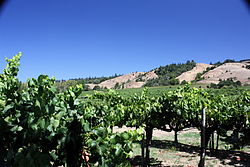Mendocino County wine
| Wine region | |

A Mendocino County vineyard in the Anderson Valley
|
|
| Type | U.S. County |
|---|---|
| Year established | 1850 |
| Country | United States |
| Part of | California, North Coast AVA |
| Sub-regions | Anderson Valley AVA, Cole Ranch AVA, Covelo AVA, Dos Rios AVA, Eagle Peak Mendocino County AVA, McDowell Valley AVA, Mendocino AVA, Mendocino Ridge AVA, Potter Valley AVA, Redwood Valley AVA, Yorkville Highlands AVA |
| Total area | 3,878 square miles (10,044 km2) |
| Size of planted vineyards | 15,000 acres (61 km2) |
| Grapes produced | Barbera, Cabernet Franc, Cabernet Sauvignon, Carignane, Charbono, Chardonnay, Chenin blanc, Gewürztraminer, Grenache, Malbec, Merlot, Muscat Canelli, Petit Verdot, Petite Sirah, Pinot blanc, Pinot noir, Riesling, Roussanne, Sangiovese, Sauvignon blanc, Semillon, Syrah, , Viognier, Zinfandel |
The Mendocino County wine is an appellation that designates wine made from grapes grown mostly in Mendocino County, California. The region is part of the larger North Coast AVA and one of California's largest and most climatically diverse wine growing regions. Mendocino County is one of the northernmost commercial wine grape regions in the state with two distinct climate zones separated by the Mendocino Range. Ten American Viticultural Areas have been designated within Mendocino County. Mendocino is one of the leading wine growing regions for organically produced wine grapes. Nearly 25% of the acreage in Mendocino County is grown organically. In 2004, the residents of the county voted to become the first GMO-free county in the United States in an initiative that was supported by many of the county's largest wineries. The county's widespread focus on organic viticulture has inspired journalists to describe it as "California's organic wine Mecca".
The name "Mendocino" comes from the family name of Mendoza in honor of the 16th century Spanish explorer Lorenzo Suárez de Mendoza, 4th conde de la Coruña who explored the Mendocino coast line and his cousin, Antonio de Mendoza the first viceroy of New Spain. The first vineyards in Mendocino were established in the 1850s in the Redwood Valley by returning farmers who failed to find their wealth and prosperity during the California Gold Rush. Most of these winery operations stayed small and were completely eradicated by the enactment of Prohibition in the United States in the early 20th century. With the commercial production of wine banned, vineyards were ripped out and replaced with tree nut and fruit orchards.
...
Wikipedia
